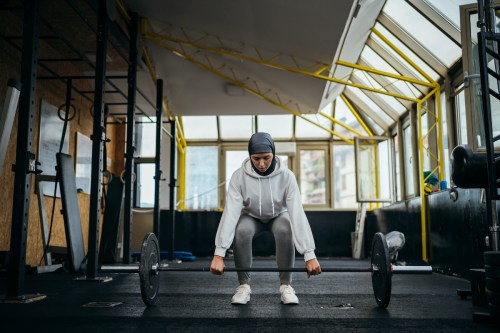Get More Out of Your Squats By Making This Simple Foot-Positioning Adjustment
Grounding your toes when squatting can improve your strength training sessions and reduce your risk of injury.

At some point in time, you’ve probably had a trainer, coach, or fitness instructor cue you to “shift your weight back into your heels” so that you’re able to easily lift your toes off the ground when performing any type of squat variation. But according to David Jou, DPT, co-founder of Motivny, squatting with your entire foot connected to the ground, aka grounding your toes, can help you train more efficiently, improve your strength and power output, and prevent injury.
“Our feet are covered in nerve endings that are meant to receive information for stance, proprioception, and locomotion. And the ground provides very useful feedback when we interact with it correctly. So by grounding the toes, we can make better decisions on how we’re moving, lifting, or carrying,” says Dr. Jou.
Grounding your feet isn’t just reserved for when you squat. “Any movement that requires body control and awareness, especially when there’s a weight involved, should be performed with toes grounded, barefoot or in minimal footwear,” says Dr. Jou. Making this simple tweak and utilizing your entire foot when you lift weights and strength train decreases your risk of faulty mechanics of the hips, pelvis, and low back which can also reduce injury. “There may be a time and place for cueing someone to shift weight into the heels, but rarely do I see a situation where grounding the whole foot doesn’t clear most issues.”
If you’re unfamiliar with the concept of grounding and how to execute it during your next workout sesh, Dr. Jou says to simply think of your foot as a tripod, “gluing” the big and little knuckle of your big toe and heel down into the ground. Focus on keeping your weight at your midfoot and avoid flaring or curling your toes. This may take some time to get accustomed to, but at the end of the day, it’ll make your workouts more efficient.
Dr. Jou also recommends implementing this foot-placement technique with any close-chained movements such as staggered-stance exercises, like the kickstand deadlift, and single-leg exercises, such as pistol squats. If your training program includes exercises to improve your power, such as squats and deadlifts, grounding your feet is a must. “With more contact on the ground, you’ll get a more stable base, which allows for more efficient transfer of power,” he says. Because you’re adjusting your technique, Dr. Jou advises using just your body weight to begin with or performing the exercises with a light weight until you get acclimated to the new foot position. No matter your training goals, grounding your feet can improve your overall performance, and really, what’s better than that?
Now that you know how to make your strength workouts more efficient, put this new technique to use with this 10-minute equipment-free lower-body strength workout:
Oh hi! You look like someone who loves free workouts, discounts for cult-fave wellness brands, and exclusive Well+Good content. Sign up for Well+, our online community of wellness insiders, and unlock your rewards instantly.
Sign Up for Our Daily Newsletter
Get all the latest in wellness, trends, food, fitness, beauty, and more delivered right to your inbox.
Got it, you've been added to our email list.










